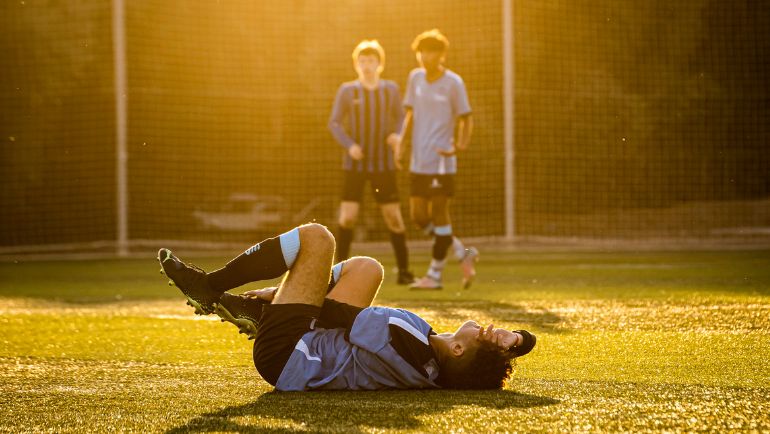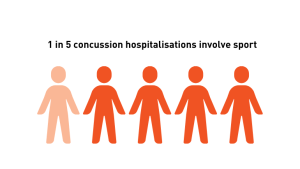Sports-related concussion

A concussion is also known as a mild traumatic brain injury (mTBI). It happens when a bump, blow, or jolt to the head, or even a hit to the body that causes the head to move rapidly, which disrupts the brain’s normal function.
There is no single test that can confirm a concussion, and it doesn’t always show up immediately. Concussions can happen in both contact and non-contact sports, during games or training. Every concussion is unique and there is no way to know if a certain incident will cause a concussion. It is estimated that there are 180,000 cases of concussion in Australia each year. We do not know the real number of concussions as not everybody seeks medical attention for a concussion.
Common causes include:
- Impact with another athlete
- Contact with equipment, such as a ball, stick, or goal post
- Impact with the playing surface
- A fall or wipe-out.
How is a concussion defined?
You hear the term concussion come up but how is concussion defined? A concussion is the mildest form of a traumatic brain injury. There currently is no universally accepted definition of concussion but Queensland Brain Institue (QBI), explains concussion medically as;
- Rapid impairment in brain function that is temporary and gets better by itself.
- A variety of symptoms, but not necessarily loss of consciousness.
- Disturbance to the brain’s function rather than physical structure which means that standard neuroimaging tests such as MRIs and CT scans can’t detect any changes.
- Symptoms that gradually improve over time, but which may be prolonged in a small percentage of people.
When someone gets a concussion, not only are the brain cells damaged, but it also kicks the brain’s immune system into action. This system sends out chemicals that cause inflammation to help start the healing process. Normally, this inflammation is a good thing because it helps repair the damage. However, if the inflammation goes on for too long, it can cause more harm than good.

What are the signs of a concussion?
A concussion should be suspected in anyone who has received a direct impact to the head or body that causes the head to move suddenly or forcefully. As concussions are an invisible injury, sometimes the diagnosis is missed. The immediate signs to look out for include:
Immediate signs of concussion to look for include:
- upper limb muscle rigidity or spontaneous movement
- loss of overall body tone
- loss of control of the neck (“rag doll effect”)
- lack of co-ordination, such as stumbling, or an inability to walk a straight line
- a fit/seizure
- balance difficulty
- slow responses
- vacant stare or appearing dazed
- confusion
- disorientation – not sure of the time and place
- no memory of events immediately before or after the injury
- holding the head
- facial injury
- inability to speak coherently or slurred.
After the initial injury people describe the following symptoms:
- headache or a feeling of pressure in the head
- nausea or vomiting
- confusion or difficulty concentrating
- memory loss or difficulties
- poor attention & concentration
- dizziness or difficulty balancing
- tiredness and fatigue
- changes in vision, such as double or blurry vision, or ‘seeing stars’
- ringing in the ears
- sensitivity to light
- loss of smell or taste
- trouble falling asleep
- intolerance of bright light & loud noise
- mood disturbances, including feeling sad, irritable, and frustrated
- sleep difficulty
- lethargic, low motivation
- slow reaction.
Just one sign or symptom is enough to indicate that a person may have experienced a concussion. Because the damage caused by concussion is too small to show up on imaging tests like CT and MRI scans, a doctor will make a diagnosis based on neurological and cognitive examinations.
Why concussion matters
After a concussion occurs, the brain is more vulnerable to further injury. Returning back to sport too early increases the risk of more serious and lasting problems. Over 90% of concussions don’t involve loss of consciousness, so don’t wait for someone to “pass out” to take it seriously. Each concussion is unique, and recovery times can vary from person to person. The safest approach is “If in doubt, sit them out and get checked by a medical professional.” Returning to play too soon raises the risk of serious, long-term damage.
Sources:
- Australian Mild Traumatic Brain Injury Study (AUS-mTBI), Accessed September 2025: https://www.hopkinscentre.edu.au/project/australian-mild-traumatic-brain-injury-study-aus-169
- Concussions in Australia over the last decade, Accessed September 2025: https://www.aihw.gov.au/reports/australias-health/concussions
- Concussion in sport, Accessed September 2025: https://www.ausport.gov.au/concussion
- What is mild TBI or Concussion?, Accessed September 2025: https://www.connectivity.org.au/symptoms-and-care/what-is-mild-tbi-or-concussion/